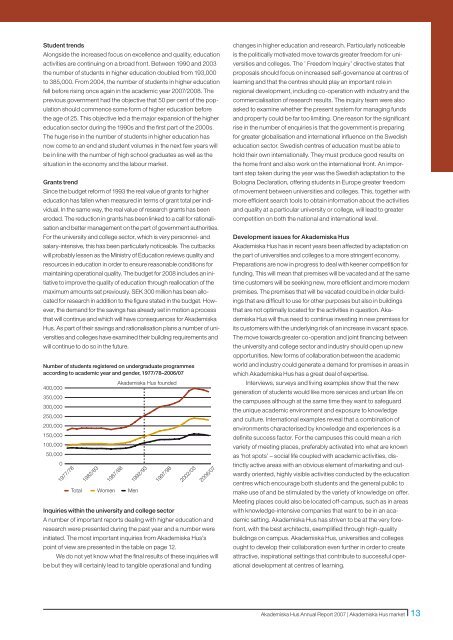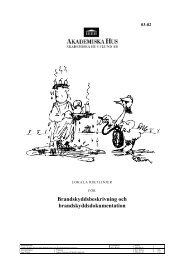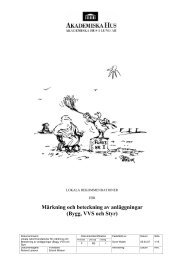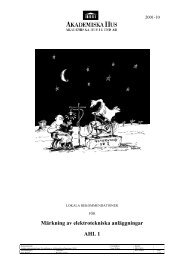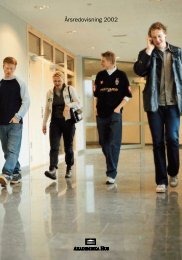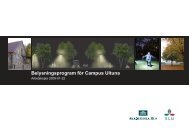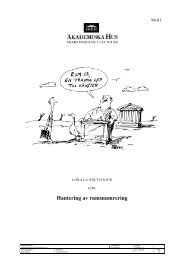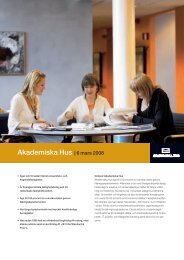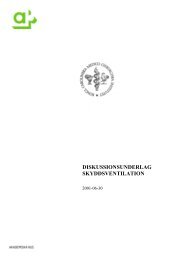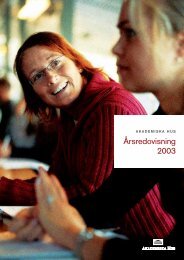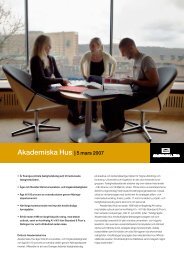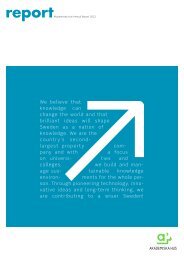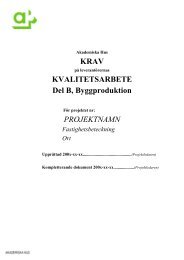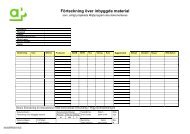Akademiska Hus Annual Report
Akademiska Hus Annual Report
Akademiska Hus Annual Report
You also want an ePaper? Increase the reach of your titles
YUMPU automatically turns print PDFs into web optimized ePapers that Google loves.
Student trendsAlongside the increased focus on excellence and quality, educationactivities are continuing on a broad front. Between 1990 and 2003the number of students in higher education doubled from 193,000to 385,000. From 2004, the number of students in higher educationfell before rising once again in the academic year 2007/2008. Theprevious government had the objective that 50 per cent of the populationshould commence some form of higher education beforethe age of 25. This objective led a the major expansion of the highereducation sector during the 1990s and the first part of the 2000s.The huge rise in the number of students in higher education hasnow come to an end and student volumes in the next few years willbe in line with the number of high school graduates as well as thesituation in the economy and the labour market.Grants trendSince the budget reform of 1993 the real value of grants for highereducation has fallen when measured in terms of grant total per individual.In the same way, the real value of research grants has beeneroded. The reduction in grants has been linked to a call for rationalisationand better management on the part of government authorities.For the university and college sector, which is very personnel- andsalary-intensive, this has been particularly noticeable. The cutbackswill probably lessen as the Ministry of Education reviews quality andresources in education in order to ensure reasonable conditions formaintaining operational quality. The budget for 2008 includes an initiativeto improve the quality of education through reallocation of themaximum amounts set previously. SEK 300 million has been allocatedfor research in addition to the figure stated in the budget. However,the demand for the savings has already set in motion a processthat will continue and which will have consequences for <strong>Akademiska</strong><strong>Hus</strong>. As part of their savings and rationalisation plans a number of universitiesand colleges have examined their building requirements andwill continue to do so in the future.Number of students registered on undergraduate programmesaccording to academic year and gender, 1977/78–2006/07400,000350,000300,000250,000200,000150,000100,00050,00001977/781982/831987/88Total Women Men<strong>Akademiska</strong> <strong>Hus</strong> founded1992/931997/98Inquiries within the university and college sectorA number of important reports dealing with higher education andresearch were presented during the past year and a number wereinitiated. The most important inquiries from <strong>Akademiska</strong> <strong>Hus</strong>’spoint of view are presented in the table on page 12.2002/032006/07We do not yet know what the final results of these inquiries willbe but they will certainly lead to tangible operational and fundingchanges in higher education and research. Particularly noticeableis the politically motivated move towards greater freedom for universitiesand colleges. The ’ Freedom Inquiry’ directive states thatproposals should focus on increased self-governance at centres oflearning and that the centres should play an important role inregional development, including co-operation with industry and thecommercialisation of research results. The inquiry team were alsoasked to examine whether the present system for managing fundsand property could be far too limiting. One reason for the significantrise in the number of enquiries is that the government is preparingfor greater globalisation and international influence on the Swedisheducation sector. Swedish centres of education must be able tohold their own internationally. They must produce good results onthe home front and also work on the international front. An importantstep taken during the year was the Swedish adaptation to theBologna Declaration, offering students in Europe greater freedomof movement between universities and colleges. This, together withmore efficient search tools to obtain information about the activitiesand quality at a particular university or college, will lead to greatercompetition on both the national and international level.Development issues for <strong>Akademiska</strong> <strong>Hus</strong><strong>Akademiska</strong> <strong>Hus</strong> has in recent years been affected by adaptation onthe part of universities and colleges to a more stringent economy.Preparations are now in progress to deal with keener competition forfunding. This will mean that premises will be vacated and at the sametime customers will be seeking new, more efficient and more modernpremises. The premises that will be vacated could be in older buildingsthat are difficult to use for other purposes but also in buildingsthat are not optimally located for the activities in question. <strong>Akademiska</strong><strong>Hus</strong> will thus need to continue investing in new premises forits customers with the underlying risk of an increase in vacant space.The move towards greater co-operation and joint financing betweenthe university and college sector and industry should open up newopportunities. New forms of collaboration between the academicworld and industry could generate a demand for premises in areas inwhich <strong>Akademiska</strong> <strong>Hus</strong> has a great deal of expertise.Interviews, surveys and living examples show that the newgeneration of students would like more services and urban life onthe campuses although at the same time they want to safeguardthe unique academic environment and exposure to knowledgeand culture. International examples reveal that a combination ofenvironments characterised by knowledge and experiences is adefinite success factor. For the campuses this could mean a richvariety of meeting places, preferably activated into what are knownas ‘hot spots’ – social life coupled with academic activities, distinctlyactive areas with an obvious element of marketing and outwardlyoriented, highly visible activities conducted by the educationcentres which encourage both students and the general public tomake use of and be stimulated by the variety of knowledge on offer.Meeting places could also be located off-campus, such as in areaswith knowledge-intensive companies that want to be in an academicsetting. <strong>Akademiska</strong> <strong>Hus</strong> has striven to be at the very forefront,with the best architects, exemplified through high-qualitybuildings on campus. <strong>Akademiska</strong> <strong>Hus</strong>, universities and collegesought to develop their collaboration even further in order to createattractive, inspirational settings that contribute to successful operationaldevelopment at centres of learning.<strong>Akademiska</strong> <strong>Hus</strong> <strong>Annual</strong> <strong>Report</strong> 2007 | <strong>Akademiska</strong> <strong>Hus</strong> market 13


